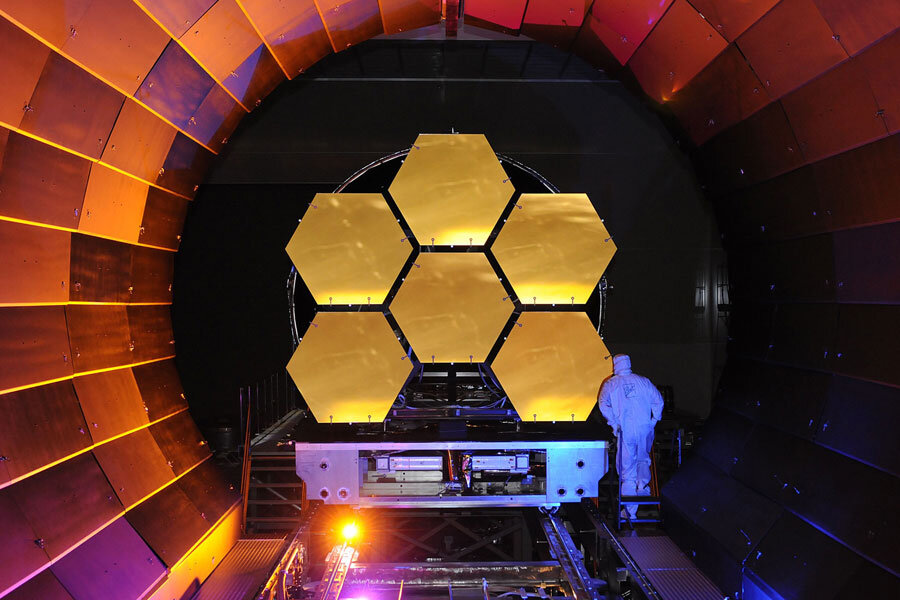Clear skies on HAT-P-11b pull back curtain on potentially habitable planets
Loading...
Cloudy skies are the bane of astronomy, on this world and on others. What hope is there of finding out if an Earth-mass extrasolar planet has an atmosphere that could support life, or that shows evidence of existing life, if you can't see past a planet's layer of high clouds?
Enter planet HAT-P-11b, a Neptune-size planet orbiting a star 124 light-years away in the constellation Cygnus. Astronomers say they have detected water vapor in its atmosphere, a detection made possible by the planet's virtually cloudless upper atmosphere.
It's the smallest and coldest planet yet to reveal some of the key constituents of its atmosphere, the researchers say, although cold is relative: The planet's temperature is estimated at some 1,580 degrees F.
The clear-sky detection is cause for a modest happy dance.
The handful of relatively small and cool extrasolar planets studied up to this point had clouds masking the bulk of their atmospheres, explains Jacob Bean, an astronomer at the University of Chicago who studies exoplanet atmospheres but was not a member of the team observing HAT-P-11b.
Those results "were very sobering," he writes in an e-mail. They implied that high-altitude clouds might be more common than not – among other things making life more difficult for the very expensive James Webb Space Telescope, which is currently slated for launch in 2018. One of its missions is to help astronomers characterize the atmospheres of planets orbiting nearby stars on hopes of finding one that is potentially habitable.
"Although HAT-P-11b is not a candidate habitable planet, it is nice that there is apparently a diversity of cloud properties. So if we first find clouds blocking our view of the atmospheres of Earth-size planets, we will have the motivation to continue looking at these objects in the hopes of seeing clear skies," he explains.
The planet has about 25 times Earth's mass and is about 4 times larger than Earth. It's kept at its roasty temperature by a close-in orbit that has it making one trip around its host star every five days. Its average distance from its star is about 5 million miles.
Previous attempts to glean information about the atmospheres of two super Earths, a Uranus-class planet, and another Neptune-class planet yielded no telltale signs of chemicals in the atmospheres, suggesting that they were masked by high-altitude clouds.
This led to the feeling among scientists that a majority of small planets may have evolved atmospheres that hosted little hydrogen and either a sheath of thick clouds or were exceptionally hazy.
As a new target for atmospheric studies, HAT-P-11b had a lot going for it, explains Drake Deming, an astronomer who specializes in the study of exoplanets at the University of Maryland in College Park. Dr. Deming led the team reporting the observation in Thursday's issue of the journal Nature.
Discovered in 2009 by NASA's Kepler mission, HAT-P-11b (also known as Kepler-3b) is one of the brightest small planets in Kepler's field of view, he explains.
The team focused on the signature of water because it's a key player in determining a planet's potential habitability.
By mapping the abundance of water in planetary atmospheres over a range of sizes from Jupiter-class planets to Neptunes, super Earths, and Earth-scale planets, "we should see the abundance of water increase" with each step toward Earth-size planets, he says. Indeed, an atmosphere's abundance of elements heavier than hydrogen and helium should rise as planets shrink in size.
The team used NASA's Hubble Space Telescope's Wide Field Camera 3, the Spitzer Space Telescope, as well as Kepler data to monitor the planet as it eclipsed its star with each orbit. Hubble's camera gathered the spectra from the planet's atmosphere, in addition to tracking variations in the star's light, as the planet passed in front of its host star. The spectra yielded a clear signature of water, which implied a clear atmosphere, at least at high altitudes.
To be certain of their result, the team had to rule out the possibility that water's signature was coming from star spots on the surface of HAT-P-11b's host star, instead of the planet. If the spots are cold enough, they can provide a spectral signature of water that mimics the signature the team would expect to see from a transiting planet. But data from Spitzer and Kepler established that the spots aren't cold enough to confound the results.
Based on its measurements, the team estimates that HAT-P-11b's atmosphere is roughly as rich in elements heavier than hydrogen and helium as Neptune itself. The value is consistent with the theory that planets form by gradually accreting material from the disk of dust and gas surrounding their host stars – a theory astronomers are testing as they uncover other stellar systems. In this case, HAT-P-11b would have been a gas giant that formed in a region of the star's disk rich in hydrogen, gathered that a around a core of ice or rock, then migrated toward the star over time.
The water-vapor detection also served as a basis for estimating the minimum altitude at which a cloud deck would appear.
With the first clear sky measurement in hand, astronomers need to figure out what proportion of Neptune-class planets have clouds and come up with the processes by which they form, notes Eliza Kempton, an astronomer at Grinnell College in Iowa and an exoplanet specialist.
This understanding should allow researchers to pick out additional planets whose atmospheres aren't hidden behind clouds, she writes, in a commentary accompanying the HAT-P-11b results.







